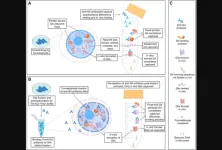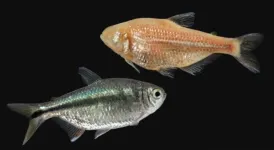(Press-News.org)
“[...] we present an improved method for G4 landscape determination and by applying it we show that sequence property-specific constraints of the nuclear environment mitigate G4 formation.”
BUFFALO, NY- March 18, 2024 – A new research paper was published in Oncotarget's Volume 15 on March 14, 2024, entitled, “G-quadruplex landscape and its regulation revealed by a new antibody capture method.”
In this new study, researchers Subhamoy Datta, Manthan Patel, Chakkarai Sathyaseelan, Chandrama Ghosh, Akanksha Mudgal, Divyesh Patel, Thenmalarchelvi Rathinavelan, and Umashankar Singh from the Indian Institute of Technology Gandhinagar, Indian Institute of Technology Hyderabad, Queen Mary University of London, Bar-Ilan University, Medical University of Lublin, and the University of Helsinki discuss a secondary structure of DNA that has attracted wide interest, G-quadruplexes or G4s.
“Our understanding of DNA G-quadruplexes (G4s) from in vitro studies has been complemented by genome-wide G4 landscapes from cultured cells.”
Conventionally, the formation of G4s is accepted to depend on G-repeats such that they form tetrads. However, genome-wide G4s characterized through high-throughput sequencing suggest that these structures form at a large number of regions with no such canonical G4-forming signatures. Many G4-binding proteins have been described with no evidence for any protein that binds to and stabilizes G4s.
“It remains unknown what fraction of G4s formed in human cells are protein-bound.”
The G4-chromatin immunoprecipitation (G4-ChIP) method hitherto employed to describe G4 landscapes preferentially reports G4s that get crosslinked to proteins in their proximity. The current understanding of the G4 landscape is biased against representation of G4s which escape crosslinking as they are not stabilized by protein-binding and presumably transient. The researchers reported a protocol that captures G4s from the cells efficiently without any bias as well as eliminates the detection of G4s formed artifactually on crosslinked sheared chromatin post-fixation. They discovered that G4s form sparingly at SINEs (short interspersed nuclear elements). An application of this method shows that depletion of a repeat-binding protein CGGBP1 enhances net G4 capture at CGGBP1-dependent CTCF-binding sites and regions of sharp interstrand G/C-skew transitions.
“The AbC G4-ChIP presents a powerful technique to decipher the cellular G4 landscape and its regulation and it has the potential to be adapted for discovering any DNA secondary structures genome-wide against which reliable antibodies are available.”
Read the full paper: DOI: https://doi.org/10.18632/oncotarget.28564
Correspondence to: Umashankar Singh
Email: usingh@iitgn.ac.in
Keywords: DNA G-quadruplexes, G4-ChIP, CGGBP1, CTCF, G/C-skew
Click here to sign up for free Altmetric alerts about this article.
About Oncotarget: Oncotarget (a primarily oncology-focused, peer-reviewed, open access journal) aims to maximize research impact through insightful peer-review; eliminate borders between specialties by linking different fields of oncology, cancer research and biomedical sciences; and foster application of basic and clinical science.
Oncotarget is indexed and archived by PubMed/Medline, PubMed Central, Scopus, EMBASE, META (Chan Zuckerberg Initiative) (2018-2022), and Dimensions (Digital Science).
To learn more about Oncotarget, visit Oncotarget.com and connect with us on social media:
X, formerly Twitter
Facebook
YouTube
Instagram
LinkedIn
Pinterest
Reddit
Spotify, and available wherever you listen to podcasts
Click here to subscribe to Oncotarget publication updates.
For media inquiries, please contact media@impactjournals.com.
Oncotarget Journal Office
6666 East Quaker Street., Suite 1A
Orchard Park, NY 14127
Phone: 1-800-922-0957 (option 2)
###
END
Prof. ZHOU Meng’s research team from the University of Science and Technology of China (USTC) of the Chinese Academy of Sciences (CAS), collaborating with Prof. WANG Quanming’s team from Tsinghua University (THU) achieved near-unity room-temperature photoluminescence quantum yield (PLQY) (>99%) in the near-infrared (NIR) emission of metal nanoclusters in solution. Their work was published in Science.
Gold nanoclusters (Au NCs) as NIR-emissive materials hold potential in biomedical applications. However, the PLQY of Au NCs in NIR region is typically low, often ...
KANSAS CITY, MO—March 18, 2024—Fatty liver, which can lead to liver damage and disease, can occur from both overeating and starvation. Now, new research shows how naturally starvation-resistant cavefish, unlike other animals, are able to protect their liver and remain healthy. The findings have implications for understanding and potentially addressing liver conditions in humans.
Researchers from the Stowers Institute for Medical Research in collaboration with Université Libre de Bruxelles in Belgium and Iowa State University ...
A research team led by Prof. WU Wenbing and Prof. WANG Linfei from the University of Science and Technology of China (USTC), in collaboration with Prof. SI Liang’ s team from Northwest University, developed a new water-soluble sacrificial layer, “super-tectragonal” Sr4Al2O7 (SAOT), with broad tunability in lattice constants, which can be used to prepare high-quality freestanding oxide membrane. Their work was published in Science.
Freestanding oxide membrane is a type of low-dimensional quantum material that maintains single-crystal properties even ...
A research team led by Prof. NI Yong and Prof. HE Linghui from the University of Science and Technology of China (USTC) of the Chinese Academy of Sciences (CAS) has developed a new composite glass combining the nacre-inspired structure and shear stiffening gel (SSG) material, maintaining transparency while exhibiting excellent thermal insulation and impact resistance. Their work was published in Advanced Materials.
Bulk glass serves as an indispensable structural material in people’s daily lives. However, glass has poor thermal ...
For many people, leaving a job can be like leaving a family — and because of the personal and professional bonds they’ve forged, many naturally stay in touch with their former coworkers and keep apprised of what’s happening in the organization.
But what happens when companies make a concerted effort to bolster those bonds, help former employees in their careers and keep them in the loop? According to new research from the UBC Sauder School of Business, it can have big benefits for both employees and employers.
For the paper, researchers studied ...
A new analysis led by researchers at the Johns Hopkins Bloomberg School of Public Health estimates that 68 percent of Chicago children under age six live in households with tap water containing detectable levels of lead.
For their analysis, the researchers used machine learning, an artificial intelligence technique, to gauge likely levels of lead in tap water in households across Chicago, based on an existing dataset that includes results from 38,385 tap water tests taken from 2016 to 2023. The tests were from households that had registered for a free self-administered testing service for lead exposure.
The threshold the researchers ...
When a star goes supernova, a massive burst of neutrinos is the first signal that can escape the density of the collapsing star. Detecting and analyzing this phenomenon in real time would allow us insight into stellar dynamics and, potentially, black hole formation. Detection of these types of signals from modern physics detectors is notoriously hard and presents computational challenges that push the bounds of modern and next-generation computing. Transmitting and analyzing the data from the massive particle physics detectors to the next generation of extreme-scale ...
Dr. James McCully of Harvard Medical School and Boston Children's Hospital, USA, invited by Dr. Marvin Edeas, from Institut Cochin, Université Paris Cité, France, will host an instructive discussion on Mitochondrial Transplantation.
This collaboration with the World Mitochondria Society (WMS) promises an insightful presentation by Dr. McCully on the topic of "Mitochondrial Transplantation: Rescue of Cellular Viability and Function and Modulation of the Ischemic Phenotype in the Myocardium." Dr. McCully will present ...
Winston-Salem, North Carolina – March 18, 2024 – The Regenerative Manufacturing Innovation Consortium (RegMIC), a leading organization focused on advancing the field of regenerative medicine, today announced its annual meeting, scheduled for May 15, 2024, at the DoubleTree by Hilton Charlotte Airport. RegMIC is an initiative from the Regenerative Medicine Development Organization (ReMDO).
This year’s meeting will convene industry leaders, researchers, and innovators to explore the latest advancements and opportunities in regenerative ...
U.S. Energy Secretary Jennifer Granholm appointed Joe Powell, the founding executive director of the Energy Transition Institute at the University of Houston, to the U.S. Department of Energy’s Industrial Technology Innovation Advisory Committee (ITIAC).
The 18-member committee, a diverse group of stakeholders who report directly to Granholm, will create a comprehensive strategy to accelerate the development of innovative technologies and processes designed to help decarbonize the American industrial sector and reduce emissions. This sector is ...









